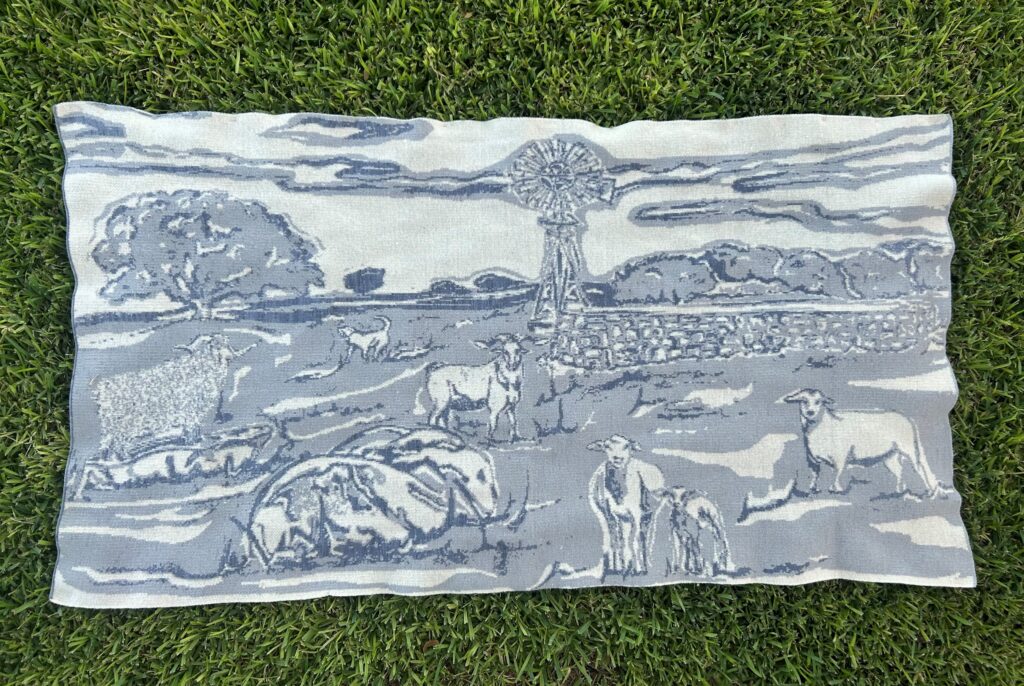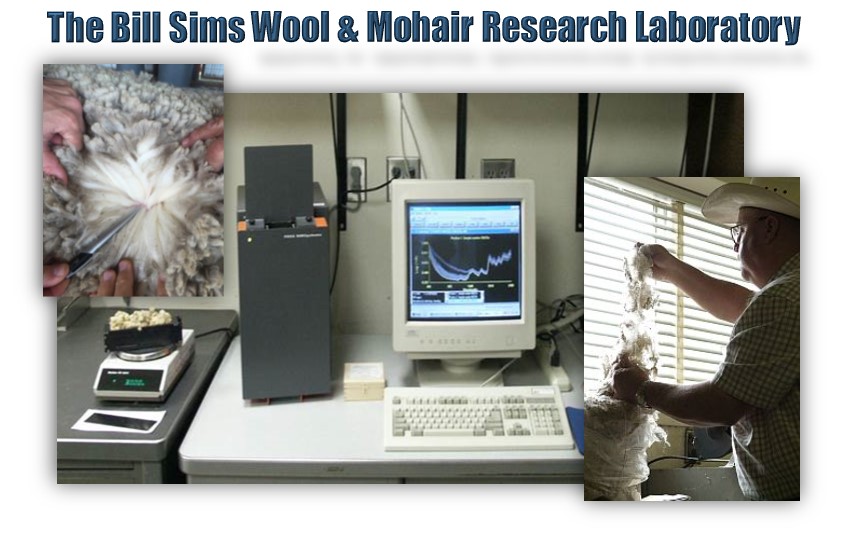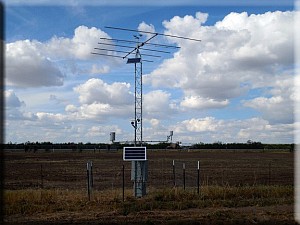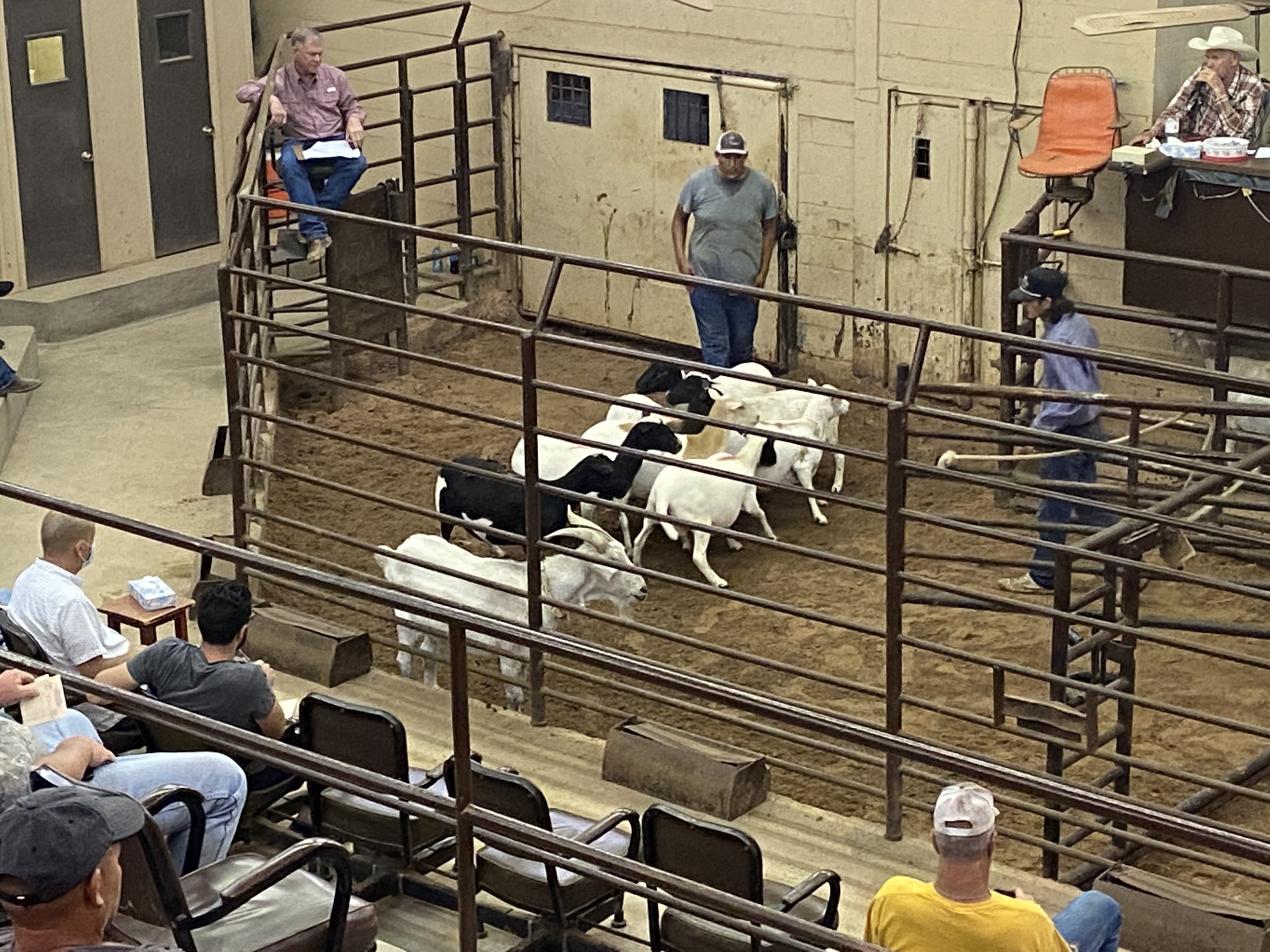Since cooler than normal temperatures are forecast for the next couple months, make sure that you are keeping your LGDs well fed during the winter months. LGDs should be in a Body Condition Score (BCS) of at least 4 at this point with normal feeding. If your LGD is below a BCS 4 you should consider providing extra feed or a better-quality feed now before winter completely arrives later this month.
AgriLife Livestock Guardian Dog Program: Events and Update
On November 17th we held our Fall LGD Webinar. Dr. Kathryn Lord from the University of Massachusetts Medical School presented a great webinar on Canine Behavior: The Socialization Period. We had over 90 producers log on to the live event. If you missed this excellent webinar, you could view it on our YouTube Channel. Our next webinar will be held on February 16, 2023, at 3 pm. Check our Facebook page for more information on that event as the date gets closer.
How Many LGDs Do You Need?
I often get asked, how many LGDs are needed on a ranch. We generally recommend 1-2 dogs per 100 head of livestock. However, that really depends on several things. Producers need to consider the following things: livestock characteristics, terrain and brush, predator load, management style, LGD behaviors, fencing and pasture size. All these things can affect the number of LGDs you need to adequately guard your livestock. I will cover the first three in this month’s edition of “The Guardian Way.” Make sure to read the January issue for part two which will include the last three things to consider.
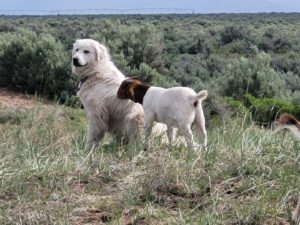
LGD with young meat goat overlooking a brushy pasture. (Texas A&M AgriLife photo courtesy Lillian Ramge 2022)
Livestock Characteristics
The number of dogs you need will also depend upon the type of livestock you own. Some types of livestock, like Dorper sheep, tend to stretch out over the land. While wool sheep and meat goats tend to stay closer together in large herds. Animals that spread out across your pastures require more LGDs to defend the area and keep the livestock safe. The larger the number of animals in a pasture, the more dogs that are needed to protect them.
Terrain and Brush
The type of terrain your property is on is a key factor in determining how many LGDs you will need. If your property is mainly open and flat, the line of sight for your dogs will be clear. If your property has hills, rocky areas and/or lots of brush, the line of sight will be blocked. Rough terrain with lots of brush makes it harder for LGDs to see and protect all the livestock. Rough brushy terrain makes it easier for predators to hide and prey on your livestock, so you need more dogs in those areas.
Predator Load
You can have fewer dogs if they only need to guard against the occasional fox, coyote, or bird of prey. However, if your LGDs are constantly on patrol, you will need more dogs. I have heard from some producers in the northern part of Texas that packs of coyotes threaten their flocks regularly. In these situations, having more LGDs protect your livestock will also reduce the risk of injury or death to your dogs.
The type of predator you dogs defend against is also important. If your dogs are defending chickens against birds of prey, their presence may be all the deterrent needed and you may only need one dog. However, if your livestock are at risk from larger predators, such as feral hogs, mountain lions, wolves, or bears, you may want a much larger group of LGDs to keep your livestock safe.
The population of your area can change the number and type of predators your LGD will need to defend your livestock from. If you live in a more rural area there will likely be more wildlife that your dogs will need to protect against. If you live in a semi-rural area and have close neighbors you may not need as many dogs, but your dogs may need to guard against town dogs attacking your livestock.
LGDs & The Bonding Project Update
Round Four Pups
All the Round Four pups are now a year old and doing well. We do progress checks every 4-6 weeks with the cooperating producers. All the producers are very happy with the pups and their progress. The pups that were bonded at the AgriLife Center will all be scored this month for socialization, roaming and overall LGD ability. The pups are scored three times at 8, 12 and 18 months of age for these three things. This scoring allows us to judge the effectiveness of our treatments over time with each round of dogs. We adjust the bonding process based on each round of scores. We will be starting the fifth round of pups in the early spring of 2023
Round Four and a Half pups, Colt and Ruger are doing well in their bonding process at the ranch in Ozona. Both pups are being bonded for
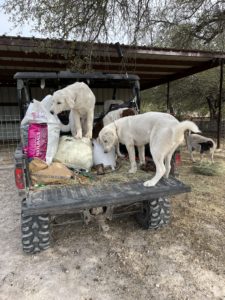
Colt and Ruger waiting for their weekly ride to acclimate them to traveling in a vehicle. (Texas A&M AgriLife photo courtesy Green 2022)
our use in a hot wire pen on the ranch. They are receiving the same socialization treatment that the normal pups in the bonding project receive. Colt and Ruger are 6 months old this month and will be moving out of the bonding pen to a small trap with some additional livestock.
Adult Dogs
We decided to split Sara and Sally up instead of sending both dogs back to Menard in November. We believe the invisible fence training along with separating the sisters will stop their playful behavior and roaming. Sara returned to her goats in Menard, but we needed an additional dog in Sonora to guard a group of goats, so Sally was chosen for the task. We will keep you updated via Facebook and this blog on how they are progressing.
In closing
If you enjoyed this monthly LGD blog, please don’t forget to subscribe to it with this link The Guardian Way | Texas A&M AgriLife Research and Extension Center at San Angelo.
To provide feedback on this article or request topics for future articles, please contact me at bill.costanzo@ag.tamu.edu or 325-657-7311.
The Texas A&M AgriLife Livestock Guardian Dog Program is a cooperative effort by Texas A&M AgriLife Research and the Texas Sheep and Goat Predator Management Board. Make sure to follow us on our social media sites and share them with your friends and family!
Facebook: https://www.facebook.com/TAMUlivestockguarddog/
Instagram: @tamulivestockguarddog
YouTube: https://www.youtube.com/channel/UCF7YbP6bNDV7___6H8mifBA
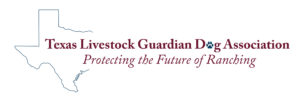 Don’t forget to check out the Texas LGD Association on online! Follow the organization at https://www.facebook.com/TexasLGDAssociation or check out their website!
Don’t forget to check out the Texas LGD Association on online! Follow the organization at https://www.facebook.com/TexasLGDAssociation or check out their website!

